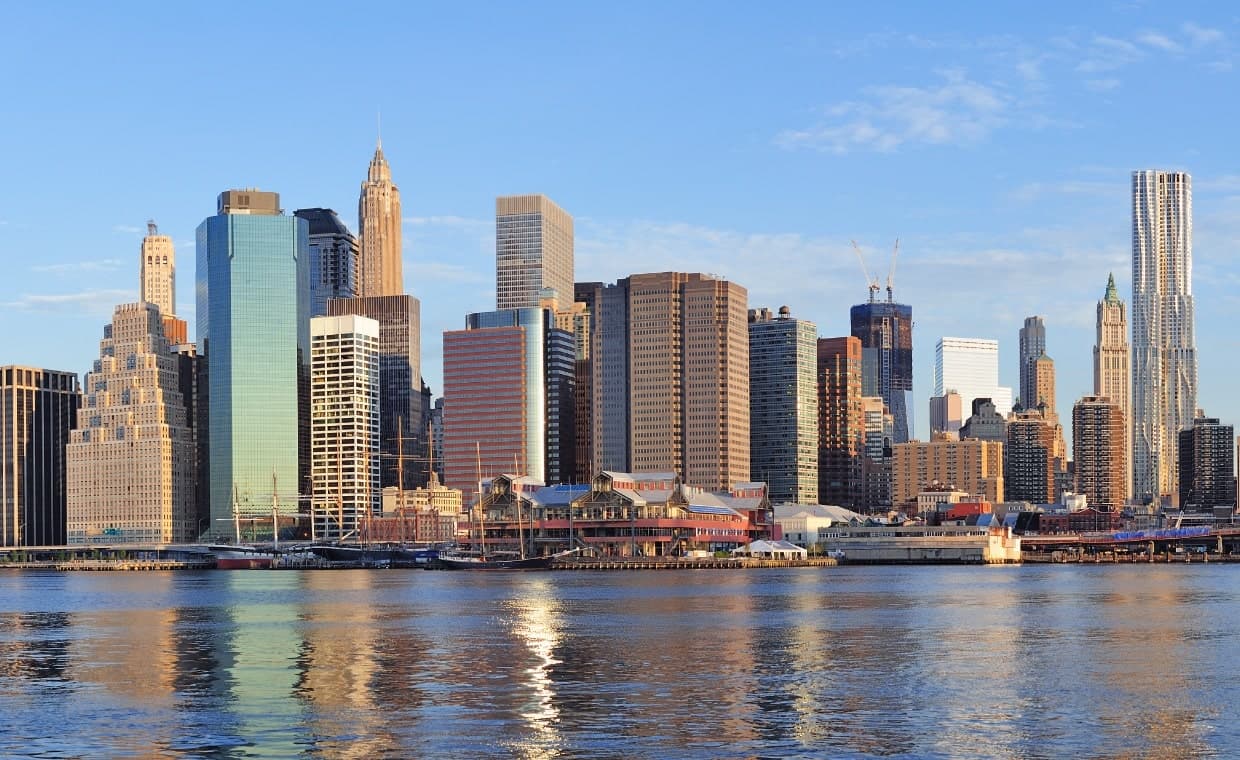
Humans have constructed towers and high-rise buildings for defence observation, round-the-clock visibility, and communication for nearly a thousand years. Although skyscrapers may seem like modern architecture, they have been around for over a century. Between 1880 and 1890, they sparked a wave of innovation that influenced later achievements. Without the American technological revolution, iconic landmarks such as the London Shard, the Burj Khalifa, and even the Empire State Building would not exist. So, if you are not aware of it and still wonder what is a skyscraper and how it is different from other buildings, this article serves all the information you need with some iconic examples of skyscrapers.
What is a Skyscraper and How Is It Different from Other Buildings?

There is no hard-and-fast rule about the minimum number of stories required to qualify as a skyscraper. The term “skyscraper” is used to describe structures with more than 20 floors. Some people only use the word for buildings with 50 floors or more. However, buildings with 100 or more floors are usually called skyscrapers.
New York’s Empire State Building has 102 floors, making its occupied height 373 meters (1,224 feet), and its spire, the tapered part at the apex of a building’s roof, adds another 230 feet. Chicago is the eighth-tallest city in the world, well-known for its skyscrapers and architectural marvels. However, not all these structures are “skyscrapers” today. Around 130 of Chicago’s tallest structures qualify as skyscrapers.
According to the ‘Council on Tall Buildings and Urban Habitat’, tall buildings or high-rise buildings are classified into two additional sub-groups based on their height, they are “supertall” and “mega-tall.” Supertall buildings are those that height 300 meters (984 feet) or more, while mega-tall buildings are those that height 600 meters (1,968 feet) or more.
Burj Khalifa or Khalifa Tower, located in Dubai, United Arab Emirates is a mega-tall tower with a height of 829.8 meters. Completed in 2010, it now stands as the world’s tallest structure. Counting only the buildings themselves and not any antennas or other structures atop them, there are only 25 structures that are taller than 1,000 feet.
The building’s height is the most obvious characteristic, but it is not the only one. There needs to be at least 50% livable space for a building to be a skyscraper. Because of this, special observation towers and other high buildings are not considered skyscrapers.
World’s First Skyscraper

In 1885, architect William LeBaron Jenney created the 10-story Home Insurance Tower, the world’s first skyscraper, in Chicago, Illinois. Using a steel frame in the building was a revolutionary technique that allowed for increased height and stability while avoiding the added weight of traditional masonry construction. The Home Insurance Building was demolished in 1931 and replaced by another skyscraper, the Field Building, also known as the LaSalle Bank Building.
5 Iconic Skyscrapers around the World
The following are some of the real-life examples of high-rise buildings:
01. The Empire State Building

The Empire State Building was completed in a record-setting one year and 45 days. This building’s height is 443 meters (1554 ft.), and it is in New York. This massive structure, constructed during the Great Depression, has stood as a symbol of the United States for seven decades, giving stability despite the country’s economic ups and downs. It was the tallest building for the longest period, from 1931 to 1972. The World Trade Center buildings in New York City surpassed it as the tallest building in the world in 1972, after it had held that title for over 40 years.
Many of the building’s available office spaces went unoccupied after its 1931 debut, which coincided with the onset of the Great Depression. The building would not start making money until 1950. One of the world’s best-known outdoor observation decks, the Empire State Building’s vantage point provides unparalleled vistas in every direction. As one of the few buildings to provide wedding packages at its observatory and as part of its ongoing effort to promote charitable causes and record major occasions, the building’s exterior lighting is subject to frequent rotation.
02. Burj Khalifa

The Burj Khalifa in Dubai is the world’s tallest structure at an astounding 828 meters (2,722 ft.). The architects of Skidmore, Owings & Merrill took inspiration from Islamic architecture when designing this building. The 158th floor of this structure, already the tallest in the world, is also the world’s highest mosque. The skyscraper is significantly taller than New York’s iconic Empire State Building by more than two times. At 828 meters in height, Burj Khalifa stands out like a huge redwood amid a field of daisies above its metropolis. This skyscraper has become the emblem of Dubai’s prosperity due to its striking contrast with the city’s other skyscrapers.
03. Petronas Twin Towers

César Pelli designed the Petronas Twin Towers to showcase Malaysian culture and tradition. Therefore, he drew inspiration from the Islamic arabesques and the repeated geometric principle of Muslim architecture. The building stands tall at 452m (1483ft) height
The tallest twin buildings in the world are an eye-catching feature in an otherwise understated cityscape. Despite this, the towers continue to hold the title of the world’s highest twin skyscrapers. The Skybridge, the highest two-story bridge in the world, connects the two buildings at Levels 41 and 42, and the observation deck is located on Level 86, where visitors may take in the sights. The sky bridge connecting the two skyscrapers was completed in 1996 and represents a gateway to the future and Malaysia’s lofty goals as the new millennium.
The sky bridge is not bolted to the main construction, but is rather made to move in and out of the towers to prevent it from breaking in strong winds. The sky bridge also serves as a safety feature, allowing occupants of one tower to flee to the other via the connecting structure in the event of a crisis. The foundations for the towers go as deep as 374 feet because of the soft land on which they stand.
04. Taipei Tower

Taipei 101 takes its cues from classic Chinese architecture, much like the Jin Mao Tower. The 101 chapters, designed by Chu-Yuan Lee and C.P. Wang and completed in 2004, the structure is meant to seem like a sprouting bamboo stalk, representing Chinese culture’s resilience and durability.
From 2004 until 2009, it was the tallest building in the world. It was the first to surpass the half-kilometer milestone. It’s also worth noting that Taipei 101 is home to the world’s fastest passenger elevator. From the fifth level to Taiwan’s highest point, it takes only 37 seconds and a dizzying 1,010 meters per minute.
The Taipei 101, at a height of 508 m (1,667 feet), held the record for the world’s tallest building until the Burj Khalifa was completed in 2010. Because of the frequency and severity of earthquakes and typhoons in the Taipei area, Taipei 101 is equipped to withstand both.
05. Burj Al Arab

The Burj Al Arab Jumeirah reaches a height of 321m (1053 ft.). It’s 14m taller than the Eiffel Tower and just 60m shorter than the Empire State Building.
The Burj Al Arab is located on its island, which can be reached through a private, curved bridge. The skyscraper resembles a ship’s sail, signifying Dubai’s rapid urbanisation. The premium hotel, designed like a sail and located on an artificial island, gives the impression that it is docking at Jumeirah Beach. Tom Wright, an architect born in the United Kingdom, was responsible for designing the building. The Burj Al-Arab, whose design was inspired by the dhow, has come to represent Dubai’s penchant for ostentation. The sailboat is actually a man-made island with a beach and a winding bridge leading to the rest of the city. Guests at one of its restaurants can take in breathtaking views of Dubai at an altitude of 660 feet, high above the Persian Gulf.
Conclusion
We hope, you have a clear idea about what is a skyscraper. Every high-rise building is custom-made to accommodate the specific requirements of its occupants, the environmental conditions in which it will be built, and the aesthetic goals of its owner and architect. Every structure is built in a special way.
As per the latest news, despite multiple plans and the stalled construction of Saudi Arabia’s Jeddah Tower, no other structure appears to become a megatall in the years ahead. The allure of constructing to such heights, with all the costs, risks, and attention that comes with it, appears to be waning.
Image Courtesy: Image 3, Image 4
Author Bio
Nafisa Nazneen Choudhury – Nafisa Nazneen Choudhury is a Civil Engineer (completed B.E. from Assam Engineering College) and is currently pursuing M.Tech in Structural Engineering at National Institute of Technology, Silchar. She is a Technical Content Writer, having over 3 years of experience and has wrote many articles related to Civil Engineering. She is also a Book Author (Authored – “Dream Tales of NNC: Revenge By Murder”) and her book can be found on Amazon. She is also a Guest Author at Gharpedia. Moreover, she is a certified member at Institution of Civil Engineers (ICE) and National Society of Professional Engineers (NSPE). She writes her blogs at her website – nnc2017.wordpress.com. She can be reached on LinkedIn.






























